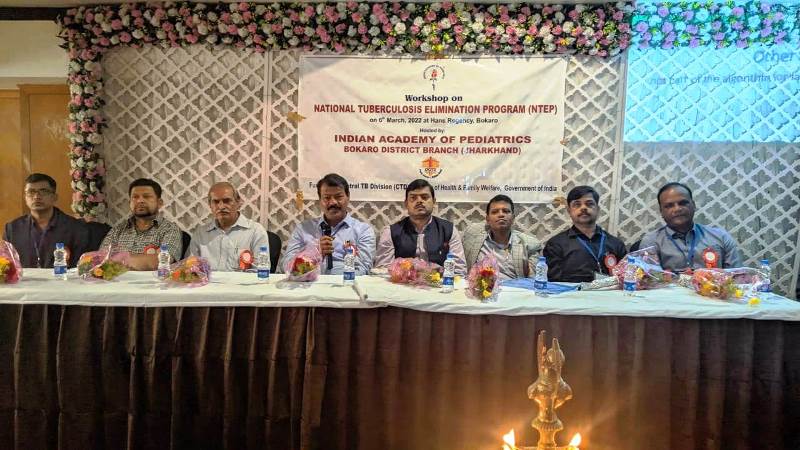The Indian Academy of Paediatrics (IAP), Bokaro Branch has committed to providing TB-free air for every child in the district. On Sunday, the IAP organised a National Tuberculosis Elimination Programme (NTEP) in which prominent paediatricians and doctors discussed treatment protocols for Tuberculosis and how to maintain a uniform and standardised treatment plan.
A scientific workshop was organized by the IAP Bokaro chapter in the Hans Regency hall. District tuberculosis officer, Dr N P Singh was the chief guest of the function. Dr L K Thakur, secretary of IAP, Bokaro, said several paediatricians, physicians, pathologists, and medical officers attended the workshop.
In addition, Dr Thakur said, “the main objective of the workshop is to increase the skills and knowledge of paediatricians and physicians so that they can diagnose and treat children with tuberculosis more effectively to achieve the goal of eliminating tuberculosis from our country by 2025.”.
As vice president of IAP East Zone, Dr Sudhir Mishra of Tata Main Hospital (TMH) gave a talk on ‘Pulmonary Tuberculosis: Role of Radiology in Diagnosis’ and on ‘Special Condition : HIV and TB, Neonate born to TB mother’, which was highly appreciated.
Dr. Anitabh Kumar, Consultant pediatrician of Santevita Hospital, Ranchi, spoke about his experiences with extrapulmonary tuberculosis (lymph node TB, pleural TB, abdominal TB, bone and joint TB, neuro TB). The Senior Paediatrician and DNB teacher at Rani Hospital, Ranchi, DR Shailesh Chandra presented on ‘Pulmonary TB Diagnostic Algorithm’, ‘Treatment of TB’, and ‘Drug Resistant TB’.
The event was also attended by other prominent names from the district, including Dr S C Munshi, Dr B Prasad, Dr Mithilesh Kumar, Dr Sanjay Singh, Dr Chandrai (BGH) and Dr Arjun Prasad. Dr L K Thakur pointed that revised National tuberculosis control programme was renamed as National Tuberculosis Elimination Programme (NTEP) in 2020. Delay in TB diagnosis and treatment initiation lead to poor outcome in children.
National Tuberculosis Elimination Program (NTEP) and Indian of Academy of Pediatrics (IAP) have partnered to develop updated guidelines and training program for management of childhood TB in the country.

World Health Organization (WHO) announced the End TB strategy with the target of reducing tuberculosis (TB) deaths by 90% and 95%, and, incidence by 80% and 90%, by 2030 and 2035, respectively. However, Government of India has decided to aim TB elimination from our country by 2025, ahead of the global target. Childhood TB is an important area of intervention while drawing the road-map to end TB.
How Does It Impact the Diagnosis of TB in Children?
Conventional TB diagnostics for children involved appropriate use of clinical details, chest radiology and tuberculin skin test, with much less focus on micro-biology, due to poor yield (AFB smear) or access issues (MTb cultures). U-DST strategy has led to change in the diagnostic pathways to include NAAT for every patient where a biological specimen can be procured. Routine chest imaging is done as initial screening test as testing of respiratory specimens from radiologically positive cases improves the yield of NAAT.
While NAAT has higher sensitivity than the smear, yet it fails in many paucibacillary cases. It is good only as a ‘rule in’ test and a negative NAAT does not rule out TB. The conventional methods of clinical diagnosis still need to be relied upon among those who are not confirmed by molecular tests. Current algorithm for evaluation of a child with pulmonary TB is shown in Fig. 1.
MANAGEMENT OF CHILDHOOD TB
What Is New in Treatment?
Treatment of TB has also evolved from erstwhile standard regimens based on the likely risk of drug resistance (new versus retreatment cases) to regimens based on identification of key resistance. The evidence available earlier in 70s suggested that the retreatment cases could be treated with a simpler 5 drug category II regimen. However, post implementation operational research and meta-analysis showed that this strategy was associated with increased risk of treatment failure with amplification of resistance to other companion drugs, particularly, if the patient was initially harboring rifampicin resistance. With the feasibility of upfront rapid testing for rifampicin resistance, use of standard regimens without sensitivity testing is no more recommended for both the new as well as retreatment cases.





